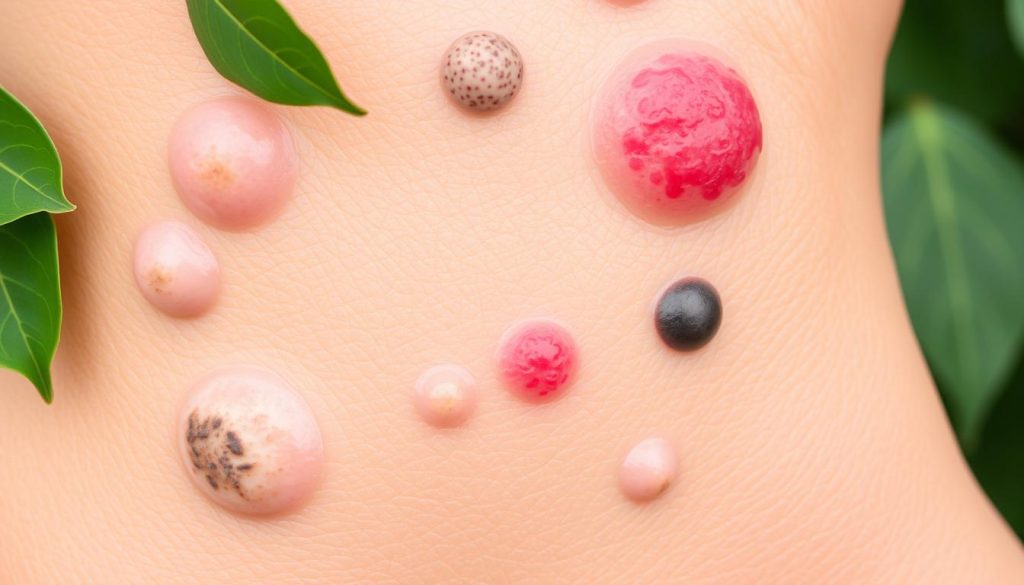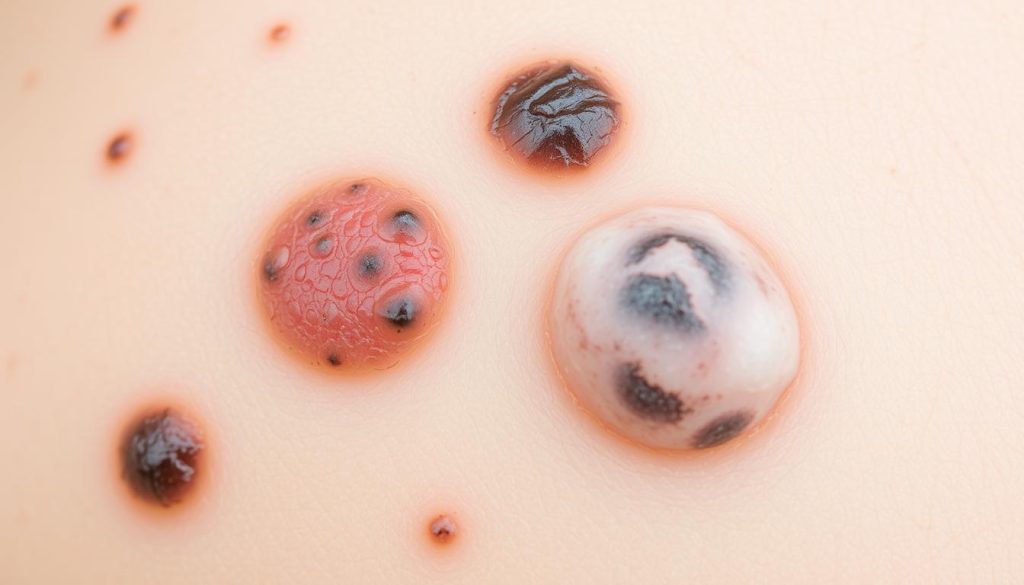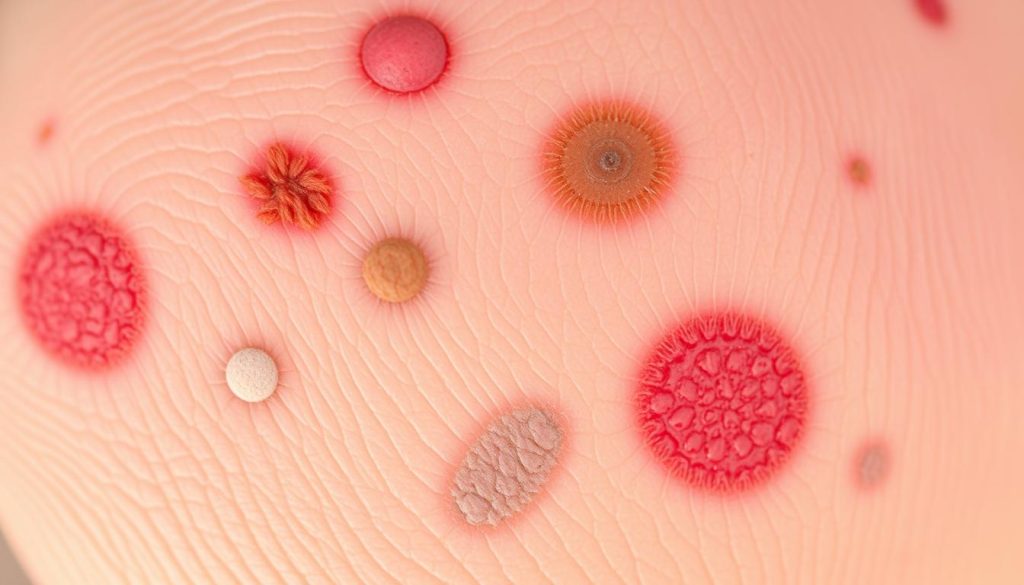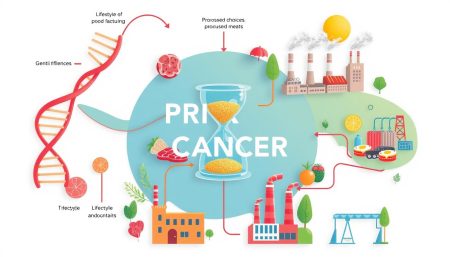Skin cancer is a serious condition that affects millions of Americans each year. Knowing the early warning signs can greatly improve treatment outcomes. This guide will help you understand key skin cancer symptoms and why early detection is important.
It’s important to watch for changes in your skin for skin cancer screening. Look out for unusual moles, sores that won’t heal, or new growths. By learning these signs, you can spot concerns and seek medical advice when needed.
Regular self-exams and professional check-ups are key to catching skin cancer early. We’ll look at different types of skin cancer, their symptoms, and how to screen for them. This will help protect your skin health.
Understanding Skin Cancer: Types and Prevalence
Skin cancer is a common yet serious condition that affects millions of people worldwide. Recognizing skin cancer symptoms early can make a big difference in treatment outcomes. Let’s look at the three main types of skin cancer and their unique characteristics.
Basal Cell Carcinoma Characteristics
Basal cell carcinoma (BCC) is the most common skin cancer. It looks like a pearly or waxy bump, often on sun-exposed areas like the face and neck. While BCC rarely spreads, it can cause a lot of damage if left untreated.
Squamous Cell Carcinoma Features
Squamous cell carcinoma (SCC) is the second most common type. It looks like a firm, red nodule or a flat lesion with a scaly, crusted surface. SCC can develop on any part of the body but is most frequently found on areas with high sun exposure.
Melanoma: The Most Dangerous Form
Melanoma is the most serious type of skin cancer. Melanoma signs include changes in existing moles or the appearance of new, unusual growths. Unlike BCC and SCC, melanoma can spread quickly to other parts of the body if not detected early.
| Type | Appearance | Common Location | Spread Risk |
|---|---|---|---|
| Basal Cell Carcinoma | Pearly or waxy bump | Face, neck | Low |
| Squamous Cell Carcinoma | Firm red nodule or flat scaly lesion | Sun-exposed areas | Moderate |
| Melanoma | Changing moles or new growths | Any part of the body | High |
Being aware of abnormal growths and changes in your skin is key for early detection. Regular self-examinations and professional skin checks can help identify skin cancers before they become serious health threats.
Common Skin Cancer Symptoms and Warning Signs
Spotting skin cancer early can save lives. Look out for skin lesions that change over time. These could be signs of melanoma or other cancers.

- New growths or spots on the skin
- Existing moles that change in size, shape, or color
- Sores that don’t heal within a few weeks
- Rough or scaly patches, specially on sun-exposed areas
- Itching, bleeding, or pain in a specific skin area
Not all skin changes are cancer, but it’s important to watch your skin. If you see unusual lesions or changes, see a dermatologist right away.
| Skin Cancer Type | Common Symptoms |
|---|---|
| Basal Cell Carcinoma | Pearly or waxy bump; flat, flesh-colored lesion |
| Squamous Cell Carcinoma | Firm, red nodule; flat lesion with scaly surface |
| Melanoma | Large brown spots with darker speckles; moles that change |
Knowing these symptoms helps you protect your health. Regular skin checks and quick action on any odd changes are vital. They help in early detection and treatment.
The ABCDE Rule of Melanoma Detection
Spotting melanoma early is key to effective treatment. The ABCDE rule is a helpful tool for spotting moles that might be cancerous. It helps you identify signs that need a doctor’s check-up.
Asymmetry Assessment
See if one half of a mole looks like the other. If not, it could be a sign of melanoma. Try drawing a line down the middle and compare both sides.
Border Irregularities
Look at the edges of your moles. Healthy moles have smooth, even borders. If the edges are jagged or blurry, it might be melanoma.
Color Variations
Check for moles with different colors or uneven color. Healthy moles usually have one color. Melanomas can have brown, black, red, or blue spots.
Diameter Concerns
Measure moles bigger than 6 millimeters (like a pencil eraser). While some melanomas are small, this size is a good guide for spotting suspicious moles.
Evolution and Changes
Watch for changes in your moles over time. Any changes in size, shape, color, or texture could mean melanoma. Keep a record of your moles to track any changes.
Using the ABCDE rule can help you catch melanoma early. But remember, not all melanomas follow these rules. If you notice anything odd, see a dermatologist right away.
Identifying Suspicious Mole Changes

Spotting mole changes is key to catching skin cancer early. Doing self-exams regularly can help find problems before they get worse. Look for any changes in size, shape, color, or texture of your moles.
Size is important when it comes to moles. If a mole grows bigger than a pencil eraser, it’s a sign to see a doctor. Also, watch for shape changes. If a mole that was once round becomes irregular or asymmetrical, it’s time for a check-up.
Color changes in a mole can be a warning sign. Look for different shades of brown, black, or red. If a mole starts to show new colors, it’s a cause for concern. Also, if a mole becomes rough, scales, or bleeds, you should see a doctor right away.
| Change Type | What to Look For | Action Required |
|---|---|---|
| Size | Growth beyond 6mm | Consult dermatologist |
| Shape | Asymmetry or irregularity | Schedule skin check |
| Color | Multiple shades or new colors | Seek professional evaluation |
| Texture | Roughness, scaling, bleeding | Immediate medical attention |
Early detection is vital. If you see any suspicious mole changes, get medical advice right away. Regular self-exams and doctor visits are a strong defense against skin cancer.
Non-Melanoma Skin Cancer Signs
Non-melanoma skin cancers show different signs than melanoma. They appear as abnormal growths or changes on your skin. It’s key to spot these signs early for timely treatment.
Persistent Sores That Don’t Heal
A sore that doesn’t heal in a few weeks is a sign of non-melanoma skin cancer. These sores might bleed or crust over again. If you have a sore that won’t go away, see a dermatologist.
Rough or Scaly Patches
Rough, scaly patches on your skin could mean non-melanoma skin cancer. These patches feel dry and rough, often look red or pink. They might be flat or slightly raised and grow slowly.
Dome-Shaped Growths
Basal cell carcinoma shows up as a smooth, pearly, or waxy bump. These bumps have visible blood vessels and might look like harmless moles. Any new or changing growth needs a doctor’s check.
| Sign | Description | Action |
|---|---|---|
| Persistent Sore | Non-healing wound that bleeds easily | Seek medical evaluation |
| Scaly Patch | Rough, dry area that may be red or pink | Monitor and consult dermatologist |
| Dome-Shaped Growth | Smooth, pearly bump with visible blood vessels | Get professional skin check |
High-Risk Areas for Skin Cancer Development
Certain parts of your body face higher UV exposure risks and are more prone to skin cancer. Knowing these high-risk areas is key for effective skin cancer screening and early detection.
Your face, ears, neck, and hands are prime spots for skin cancer to develop. These areas often get the most sun exposure during daily activities. The scalp, specially in people with thinning hair, is another vulnerable zone.
For men, the chest and back are common sites for melanoma. Women tend to see more cases on their legs. Surprisingly, skin cancers can also form in less exposed areas like between toes or under nails.
Regular skin cancer screening of these high-risk spots is vital. Pay extra attention to these areas during your monthly self-checks. Don’t forget often-overlooked places like your lips, eyelids, and ears.
| Body Area | Risk Level | Key Factors |
|---|---|---|
| Face | Very High | Constant sun exposure, thin skin |
| Hands | High | Frequent exposure, often unprotected |
| Neck | High | Often exposed, sensitive skin |
| Ears | High | Protruding, often missed in sunscreen application |
| Scalp | Moderate to High | Direct sun exposure, harder to check |
Knowing these high-risk areas empowers you to take proactive steps in skin cancer prevention and early detection. Stay vigilant and protect these vulnerable spots from harmful UV rays.
UV Exposure and Its Impact on Skin Health
UV exposure is key to skin health and cancer risk. Knowing the risks helps spot skin cancer early. Let’s look at how UV radiation from different sources affects our skin.
Natural Sun Exposure Risks
Sunlight is the main source of UV radiation. Without protection, it can harm our skin and raise UV risks. Sunburns, tanning, and even short times in strong sunlight cause skin damage over time.
Artificial UV Sources
Tanning beds and some lamps also give off UV radiation. These artificial sources can be as dangerous as sunlight, or even worse. Using tanning beds often increases skin cancer risk.
Cumulative Damage Effects
UV damage builds up over time, making skin cancer more likely. Each time we’re exposed, it adds to the risk. Regular skin checks are vital to catch skin cancer symptoms early.
| UV Source | Risk Level | Protective Measures |
|---|---|---|
| Natural Sunlight | High | Sunscreen, Protective Clothing, Shade |
| Tanning Beds | Very High | Avoid Use |
| UV Lamps | Moderate to High | Limit Exposure, Protective Eyewear |
Understanding UV risks and taking steps to prevent them can lower skin cancer chances. Remember, catching skin cancer early is essential for effective treatment.
Risk Factors for Developing Skin Cancer
It’s important to know your risk for skin cancer. This knowledge helps in early detection and prevention. Certain factors can increase your risk. Knowing these can help you protect against UV exposure.
Skin type is a big factor. People with fair skin, light hair, and light eyes are more at risk. Those who burn easily or have many moles are also at higher risk.
A history of sunburns, even in childhood, can raise your risk. Frequent use of tanning beds also increases risk due to intense UV exposure.
Genetic factors also play a part. If your family has a history of skin cancer, you might be more likely to get it. Certain genetic conditions can also make you more susceptible.
| Risk Factor | Impact Level | Preventive Action |
|---|---|---|
| Fair skin | High | Use high SPF sunscreen daily |
| History of sunburns | Moderate to High | Avoid peak sun hours, wear protective clothing |
| Family history | Moderate | Regular skin cancer screenings |
| Frequent tanning bed use | Very High | Avoid tanning beds completely |
Environmental factors also matter. Living in sunny areas or at high altitudes increases risk. Jobs that involve working outdoors or with chemicals can also raise your risk.
Knowing your risk doesn’t mean you’ll get skin cancer. It’s about being aware and taking steps to prevent it. Regular skin checks and screenings are key to catching issues early.
Performing Monthly Skin Self-Examinations
Regular skin self-exams are key to catching skin cancer early. Doing these checks monthly boosts your chances of finding odd changes quickly. Let’s dive into how to do a thorough skin check and what to do with any findings.
Step-by-Step Inspection Guide
Here’s how to do a complete skin self-exam:
- Look at your face, neck, ears, and scalp with mirrors
- Check your hands, including palms and between fingers
- Scan your arms, elbows, and underarms
- Inspect your torso, chest, and back with a hand mirror
- Look at your legs, feet, and between toes
Documentation Methods
Keep an eye on your skin’s changes over time:
- Take clear photos of moles or spots
- Make a body map to mark spots
- Use a skin cancer screening app to track changes
When to Seek Professional Help
See a dermatologist if you notice:
| Change | Action |
|---|---|
| New moles or growths | Schedule an appointment |
| Changes in existing moles | Seek immediate evaluation |
| Sores that don’t heal | Consult a specialist promptly |
By making skin self-exams a regular part of your routine, you’re taking charge of your health. Early detection through regular skin cancer screening can lead to better treatment results.
Advanced Warning Signs Requiring Immediate Attention
Spotting skin cancer early can save lives. Some signs appear slowly, but others need quick action. It’s key to know these signs to get help fast.
Fast-growing spots are a big warning. If a mole or spot grows quickly, see a doctor. This could mean the cancer is spreading fast.
Bleeding or oozing from a spot without injury is serious. Skin cancers can bleed as they grow deeper. Don’t ignore bleeding from a skin spot.
Big changes in moles are also a sign to see a doctor. Look for sudden color, size, or shape changes. A mole that gets darker, bigger, or has an odd shape needs a check-up.
Pain, itching, or tenderness in a spot is a worry. Not all skin cancers hurt, but new pain could mean it’s turning bad.
- Rapidly growing lesions
- Spontaneous bleeding or oozing
- Dramatic mole changes
- New pain in skin growths
If you see these signs, act fast. Get medical help right away. Quick action can help treat the cancer better.
Prevention Strategies and Protective Measures
Keeping your skin safe from harmful UV rays is key to avoiding skin cancer. Smart prevention can greatly reduce your risk. Let’s look at ways to protect your skin from sun damage.
Daily Sun Protection Methods
Start by using sunscreen to block UV rays. Choose a broad-spectrum sunscreen with SPF 30 or higher. Reapply every two hours or after swimming. Stay in the shade from 10 am to 4 pm.
Protective Clothing Choices
Wear clothes that cover your skin to reduce exposure. Long-sleeved shirts, long pants, and wide-brimmed hats are great. Look for clothes with UV protection. Also, wear sunglasses that block UV rays.
Lifestyle Modifications
Make sun safety a part of your daily routine. Avoid tanning beds and sunbathing to reduce UV risks. Plan outdoor activities when it’s cooler. Regular skin checks are important for early detection.
| Prevention Method | Effectiveness | Ease of Implementation |
|---|---|---|
| Daily Sunscreen Use | High | Medium |
| Protective Clothing | High | High |
| Seeking Shade | Medium | High |
| Regular Skin Checks | High | Medium |
Using these strategies together can help fight skin cancer. Remember, catching it early through regular checks is critical. Stay alert, protect your skin, and keep your health first.
The Importance of Regular Dermatological Screenings
Regular visits to the dermatologist are key for skin health and catching skin cancers early. These visits help your monthly self-checks by adding a professional touch. Experts give a detailed look at your skin.
Skin cancer screening is quick and painless. It can save lives. A dermatologist will check your skin from head to toe. They focus on sun-exposed areas for any suspicious moles or growths.
How often you need these checkups depends on your risk. Most people should get screened once a year. If you’ve had skin cancer before or are at high risk, you might need more visits.
Early detection is key. Many skin cancers are treatable if caught early. That’s why regular dermatology visits are vital.
If you’re curious about why skin cancer screenings are important, here are some reasons:
- Experts check your skin health
- They spot skin issues early
- You get advice on skin care
- You feel secure knowing you’re taking care of your health
| Risk Factor | Recommended Screening Frequency |
|---|---|
| No personal or family history of skin cancer | Annual |
| Personal history of skin cancer | Every 3-6 months |
| Family history of melanoma | Every 6-12 months |
| Multiple atypical moles | Every 6-12 months |
While self-exams are good, they can’t replace professional screenings. Prioritize dermatology visits for the best skin cancer prevention and early detection.
Treatment Options for Different Skin Cancer Types
Early detection is key to treating skin cancer. For basal cell carcinoma, doctors often use surgery or Mohs surgery. These methods remove cancerous tissue and leave little scarring.
Squamous cell carcinoma treatment might also involve surgery. Sometimes, radiation therapy is used, mainly for tumors in sensitive spots. Immunotherapy is also effective, helping the body fight cancer cells.
Melanoma, the most aggressive type, needs quick action. Treatment can range from surgery for early stages to targeted therapies and immunotherapies for later stages. Catching melanoma early greatly improves chances of recovery. New treatments are always being developed, giving hope to those with skin cancer.
Early detection is vital for all skin cancer types. Regular skin checks and quick medical visits for any unusual changes are essential. They greatly improve treatment success and long-term health.
FAQ
Q: What are the most common skin cancer symptoms?
A: Common symptoms include changes in moles and new growths. Look for signs like asymmetry and color changes. Also, watch for sores that don’t heal and scaly patches.
Q: How often should I perform a skin self-examination?
A: Check your skin monthly. This helps you notice changes early. Use a mirror for hard-to-see spots and keep a record of your findings.
Q: What is the ABCDE rule for melanoma detection?
A: The ABCDE rule helps spot melanomas. It stands for:
A – Asymmetry: One half doesn’t match the other.
B – Border: Edges are irregular or jagged.
C – Color: The mole has different colors.
D – Diameter: It’s bigger than 6mm.
E – Evolving: It changes in size or color.
Q: Which areas of the body are at highest risk for skin cancer?
A: The face, ears, neck, and hands are at high risk. These areas get a lot of sun. Protect them with sunscreen and clothes.
Q: How does UV exposure impact skin cancer risk?
A: UV rays from the sun and tanning beds increase cancer risk. They damage skin cells, leading to mutations. Protect your skin to lower this risk.
Q: What are the main types of skin cancer?
A: There are three main types:
1. Basal Cell Carcinoma (BCC): Common on sun-exposed areas.
2. Squamous Cell Carcinoma (SCC): Also common on sun-exposed skin.
3. Melanoma: The most dangerous, can appear anywhere and spread fast.
Q: When should I seek professional medical help for a skin concern?
A: See a doctor for any mole changes or new growths. Also, for sores that don’t heal. Early detection is key.
Q: How often should I get a professional skin cancer screening?
A: Get a full-body check annually. If you’re at high risk, your doctor may suggest more often.
Q: What are some effective prevention strategies for skin cancer?
A: Prevent skin cancer by using sunscreen and wearing protective clothes. Stay in the shade and avoid tanning beds. Regular self-exams and screenings are also important.
Q: Can skin cancer occur in areas not exposed to the sun?
A: Yes, skin cancer can happen in non-sun-exposed areas. Melanoma can appear anywhere, including palms and mucous membranes. Check all skin areas during self-exams.


















